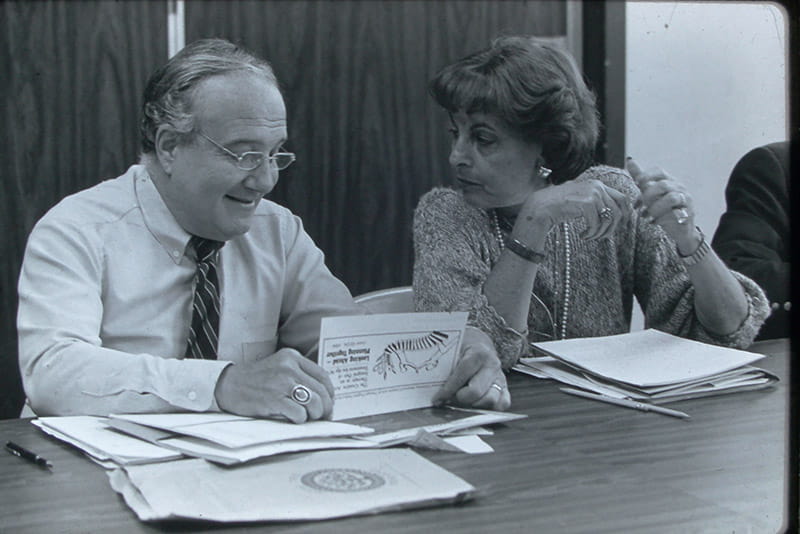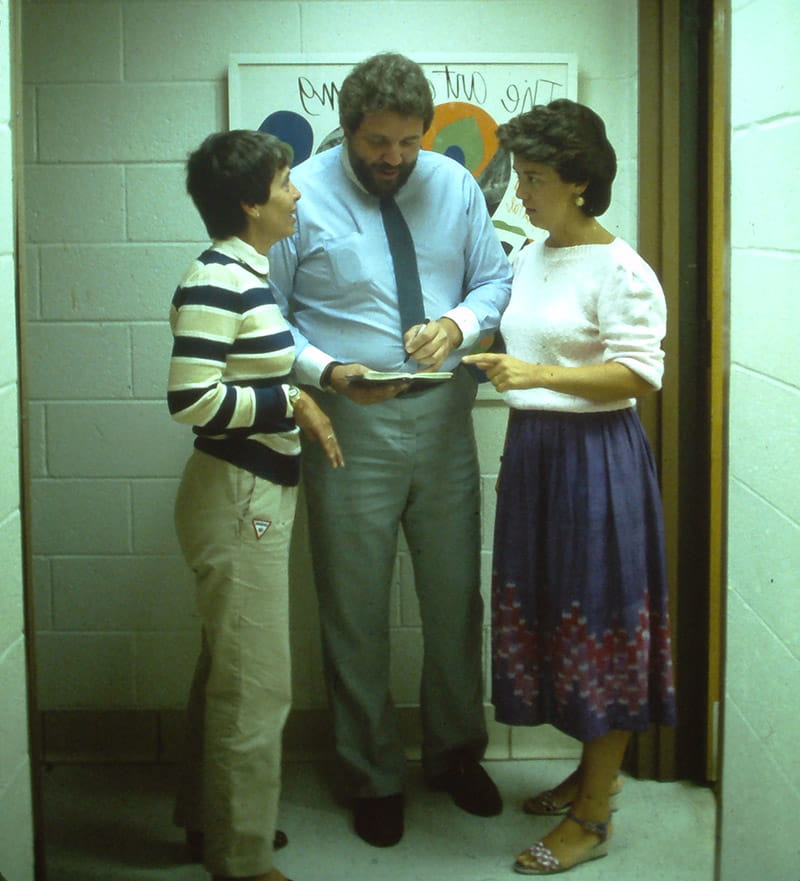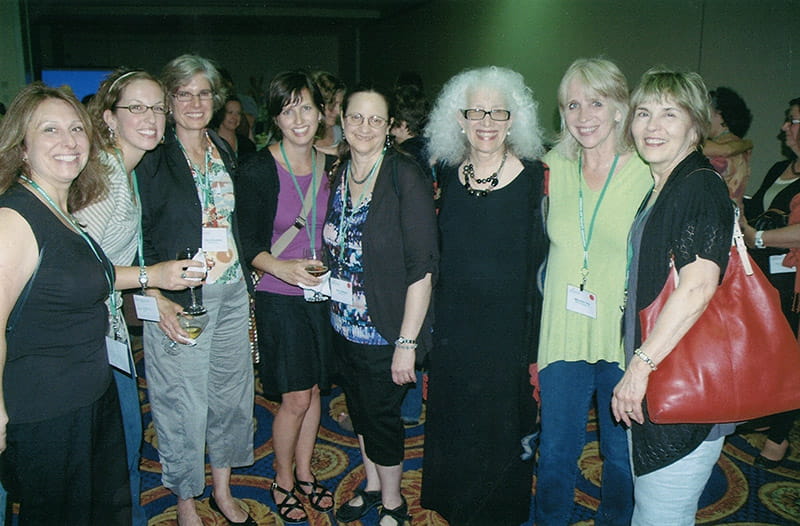Painting the Picture of 50 Years of Art Therapy at Drexel and in America

- Bolstered by Research Consortium with Drexel, Jefferson’s Sidney Kimmel Cancer Center Earns NCI Comprehensive Cancer Center Designation
- Ribbon-Cutting Ceremony Marks Official Unveiling of Drexel Station at 30th Street
- Drexel’s Pearlstein Gallery Offers Spring Exhibitions Centered on the Healing Properties of Art and Creative Works
- Express Your Thoughts About Climate Change in the Anthems for the Anthropocene Contest

In 1969, the American Art Therapy Association (AATA) was co-founded by Myra Levick, PhD, who also co-founded the world’s first graduate program in arts therapy to matriculate students at the then-Hahnemann Medical College and Hospital (which became Hahnemann University in 1981 and was absorbed by Drexel in 2002). Levick also served as the first AATA president.
Now, in 2019, with the AATA celebrating its 50-year anniversary, a Drexel professor — who graduated from the institution that initiated the program and teaches at the institution that absorbed it — was recently voted in by the membership to lead the professional organization.
Girija Kaimal, EdD, an associate professor in the College of Nursing and Health Professions’ Creative Arts Therapies Department, was recently sworn in as AATA’s President-Elect, a position she will retain for two years before becoming president of the professional organization for an additional two years.
“I feel like I’m bringing together many different roles into this leadership role,” said Kaimal. “These include being a credentialed and board-certified art therapist as well as those of being a researcher, my history of being an immigrant, an educator and a clinician.”
When Kaimal came to the U.S. from India in the late ’90s to get her MA in art therapy from Hahnemann University, Hahnemann was still a leader in the field. She graduated a year before Hahnemann University became a part of Drexel University (where it now lives on through the College of Nursing and Health Professions as well as the College of Medicine and Dornsife School of Public Health).
She returned to Drexel in 2013 to teach, and she is the department’s only full-time art therapy research faculty— which she says is unique because art therapy has historically been a clinical profession. Kaimal leads the Health, Arts, Learning and Evaluation (HALE) lab, through which she researches everything from the benefits of art therapy for veterans recovering from traumatic brain injuries and cancer caregivers to how the future of the field can be boosted by virtual reality. Her commitment to research doesn’t just stop at Drexel — it’s also led to her being named chair of the AATA research committee in 2015.

Today, the AATA is considered the leading organization for art therapy with members around the world and is the largest organization in the United States solely representing the field of art therapy. When it was founded five decades ago, the organization had just 20 members. Today, the organization is recognized around the globe with members from all parts of the world and is the leading organization of its field in the United States with over 4,000 members at any given time.
At that time of the AATA’s founding, art therapy wasn’t generally accepted, or well-known, within the medical community or the greater societal consciousness. Both the program and the professional organization were partly started to grow the burgeoning field as its own entity, outside of psychiatrics, with its separate practices, training and education related to a separate mental health discipline.
That’s what made the creation of Hahnemann’s first-of-its-kind graduate-level arts therapy program so radical. The fact that the program was housed in a medical college and a medical setting, and that its students could work alongside Hahnemann’s psychiatrists and nurses, was both a step forward and in a different direction. It started with an original class of six students — and a tragic, tumultuous beginning.
Just months after the program began, cofounder Morris J. Goldman, a psychoanalyst who was also the head of psychiatry at Hahnemann, died suddenly at age 39. Goldman had recruited Levick, a wife of a doctor with three children who had then recently graduated from the Moore College of Art with a bachelor’s degree in painting, to work with his patients — first at the Albert Einstein Medical Center North in 1963 and then at Hahnemann Medical College when he accepted a position there to start its art therapy program.
“Morris was the director because I was only an adjunct professor. They didn’t have women professors in those days,” Levick remembered. “We spent several weeks mourning this very brilliant young man, and then people from the graduate school invited me to a meeting and said they wanted the program to remain and they would have to name me an assistant professor to become director of the program.”
In addition to developing all aspects of Hahnemann’s art therapy program, Levick was also named activities director of Hahnemann’s mental health center. Less than 10 years after Hahnemann’s program was created, Levick became a tenured professor in Hahnemann’s Department of Psychiatry in 1976. She ended up working at Hahnemann for 20 years while coordinating and directing what became its Creative Arts in Therapy program, publishing books and journal articles and supporting her students.
Her work at Hahnemann informed her work to help create a formal and comprehensive professional organization for art therapists — the AATA even grew out of a meeting convened at Hahnemann in 1968. And in the beginning, Levick and the organization worked to develop a constitution, hold conferences, set and award professional standards and certifications and foster professional development and networking opportunities with practitioners across the country.
Levick retired from Hahnemann when she was 62 and moved to Florida, where she still worked out of her small private practice until she was 85. Today, the 94-year-old continues to help people through art therapy, teaching art classes at the assisted living facility in which she resides at in Pennsylvania (which 6-abc featured in a video last spring).

“The whole thing was just strange and destined to happen,” Levick said about how she got started in the profession — and continued to work in the field for another six decades.
As the need for art therapy grows in a constantly changing society, the AATA is focused on increasing public awareness, advocating for state licensure of art therapy and insurance reimbursement for clients, disseminating research, and constant review to increasing the diversity and inclusivity of a highly engaged individual membership organization.
As a prominent leader in the organization during its semi centennial anniversary year, Kaimal will have a hand in that.
“AATA’s mission, simply put, is to advance the field,” she said. “That encompasses many priorities which I hope to help advance including my professional passion for clinical research across the U.S and globally. I invite students and colleagues to participate in the American Art Therapy Association and help shape the future of the profession.”
Her participation in the organization has given her perspective on the national and global scale of the field. She’s collaborated with the leadership of other art therapy associations around the world, both through teaching in India as part of an outcome of engaging at the national level and by helping to connect colleagues and students with similar interests.
And both at Drexel and AATA, Kaimal has helped to promote others in her field by mentoring colleagues into leadership roles and encouraging her doctoral students to join on national committees and organizations.
“I do think that there are tremendous benefits to this kind of unpaid service work,” she said. “You stay current and you are able to connect people who might be doing things in isolated pockets and not realizing that others doing similar things that might be interested. That way, you become more effective in working together.”
Kaimal is part of the PhD in creative arts therapies program, which was founded by Nancy Gerber, PhD, in 2010. It is collectively an innovative and significant research contributor at Drexel, according to Director of Graduate Art Therapy Programs and Associate Clinical Professor Natalie Carlton, PhD, who was taught by Levick when she was a graduate student in Hahnemann’s creative arts therapy department.
“Alongside the master’s programs [in art therapy and counseling; dance/movement therapy and counseling; and music therapy and counseling] that are educating research-informed practitioners, the PhD program designs, implements and disseminates research that contributes to those various areas of established and emergent clinical practices,” said Carlton. “The PhD program brings in practicing creative arts therapists and turns out highly skilled researchers and educators to co-build the literature and research around the field and its professional development and visibility.”
In This Article
Drexel News is produced by
University Marketing and Communications.
